Landmarks
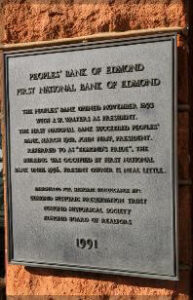 First the railroad came laying down ribbons of steel across Oklahoma’s Unassigned lands in 1887, Edmond Station being one of many coaling and watering stops on this Santa Fe line. The first permanent residents were John Steen, who worked for the railroad, his wife Cordelia and two year old son, Charlie.
First the railroad came laying down ribbons of steel across Oklahoma’s Unassigned lands in 1887, Edmond Station being one of many coaling and watering stops on this Santa Fe line. The first permanent residents were John Steen, who worked for the railroad, his wife Cordelia and two year old son, Charlie.
Edmond had a slow start on this famous day of April 22, 1889. By early afternoon over 20 passenger trains, loaded with people looking for free land and a new life, made stops at Edmond Station during the day. Many were looking for town lots and by nightfall the village was beginning to grow.
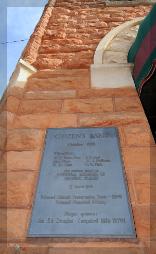 Broad Street became the major street in town. It was much wider than any other streets, mainly to accommodate horse drawn wagons loaded with goods for the new village. By 1890 the street became known as Broadway with a wide variety of shops and businesses in a two block area from 2nd Street north to Main.
Broad Street became the major street in town. It was much wider than any other streets, mainly to accommodate horse drawn wagons loaded with goods for the new village. By 1890 the street became known as Broadway with a wide variety of shops and businesses in a two block area from 2nd Street north to Main.
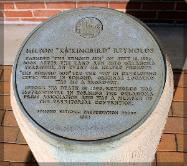 As Edmond grew, business came and went; buildings were replaced or remodeled. Today, two major Territorial bank buildings are still present on Broadway. The oldest is Peoples’ Bank, built in 1893, no longer a bank, and across the street, Citizens’ State Bank, built in 1894, which still has a downtown presence.
As Edmond grew, business came and went; buildings were replaced or remodeled. Today, two major Territorial bank buildings are still present on Broadway. The oldest is Peoples’ Bank, built in 1893, no longer a bank, and across the street, Citizens’ State Bank, built in 1894, which still has a downtown presence.
In 1951 Edmond Boy Scouts began raising money to purchase a small replica of the Statue of Liberty to be placed in the median of 2nd and Boulevard. Nearly 60 years later, after a couple of repairs and two moves, the statue again graces one of the busiest intersections in town.
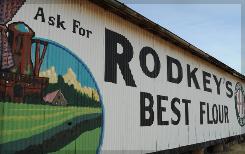 The Edmond Historic Preservation Trust was created in 1982, its mission to Preserve, Protect, and Promote Edmond’s Heritage, Landmarks, & Sites. One of the first projects was in 1984, a monument to Milton “Kickingbird” Reynolds, civic leader and founder of The Edmond Sun.
The Edmond Historic Preservation Trust was created in 1982, its mission to Preserve, Protect, and Promote Edmond’s Heritage, Landmarks, & Sites. One of the first projects was in 1984, a monument to Milton “Kickingbird” Reynolds, civic leader and founder of The Edmond Sun.
By 1993 the Trust began recognizing many of the early-day downtown businesses and their locations with a small plaque attached to the front of each building. All total in a two block area there are 38 plaques. Today, a walk of these two blocks brings history alive with names of stores of a by-gone era. Hayes Clothing in 1915 sold “All Wool Overcoats for Men” at 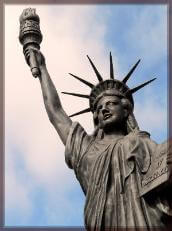 109 South Broadway. Across the street at 114 South Broadway, Paas Hardware and Funeral Home sold windmills, tinware and cooking utensils.
109 South Broadway. Across the street at 114 South Broadway, Paas Hardware and Funeral Home sold windmills, tinware and cooking utensils.
In 1891 John H. Snyder opened a grain elevator and mill west of Broadway. In 1904 it was sold and became Farmers Grain Company and has been operated by the same family since 1924. G.H. Fink, in 1916, constructed a brick building at 115 South Broadway which became The Penny Cash Store and advertised “Strictly Cash for Groceries.”
Today Broadway is still alive with businesses. Citizens’ National Bank moved across the street in a newer building. There are two newspapers and antique stores that have replaced the grocery and hardware stores of yesteryear.
The Edmond Visual Arts Commission, along with business owners and private citizens, have assembled a collection of life-size bronze statues and historic wall murals in downtown Edmond such as the Rodkey Mill sign near the railroad track.
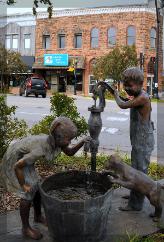 A major highway once passed through Edmond. Historic Route 66 is no longer considered a major cross county highway, however, today tourists, seeking a much slower pace of life and a little nostalgia, often are seen traveling this Old Mother Road through Edmond.
A major highway once passed through Edmond. Historic Route 66 is no longer considered a major cross county highway, however, today tourists, seeking a much slower pace of life and a little nostalgia, often are seen traveling this Old Mother Road through Edmond.
A statue of seven-time Olympic medalist, Shannon Miller graces Shannon Miller Park. A short distance away, a plaque honors pioneer land developer, Anton Classen. Tragedy struck Edmond on the morning of August 20, 1986, when a postal worker went on a rampage killing 14 co-workers and wounding six. The incident was the inspiration for the inclusion of the term “Going postal” into the American lexicon. In 1989, a statue of a man and woman holding a gold ribbon was dedicated at the Post Office.
Edmond is not without its Territorial legend. In 2007 a statue was unveiled in Farmers Market Place Plaza, near the railroad tracks. It has been said that a woman, jumping from the cowcatcher of a slow moving train, staked her claim, and then jumped back on the last car. The woman’s name was Nannitta R.H. “Kentucky” Daisey and the date was April 22,1889.
